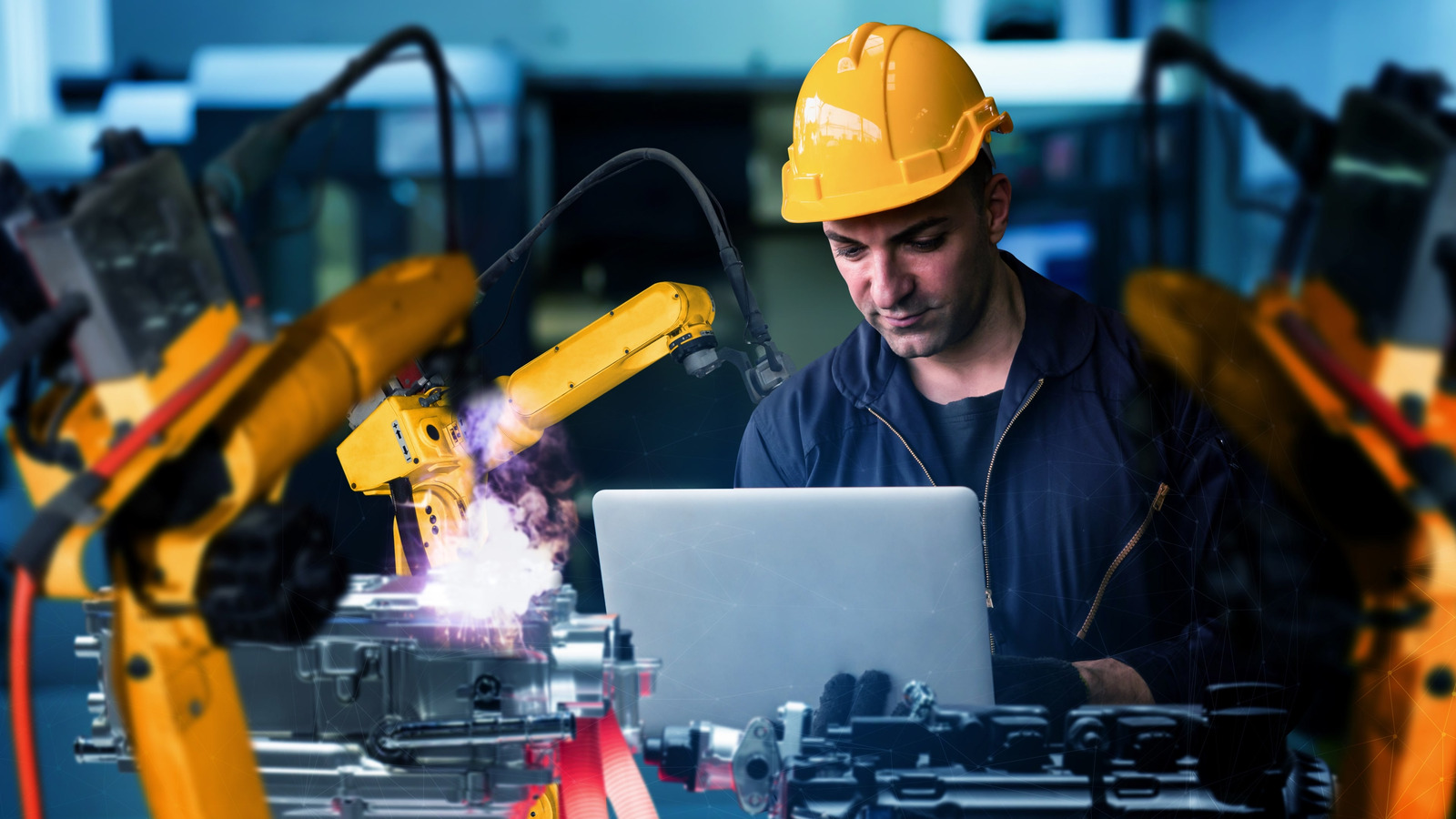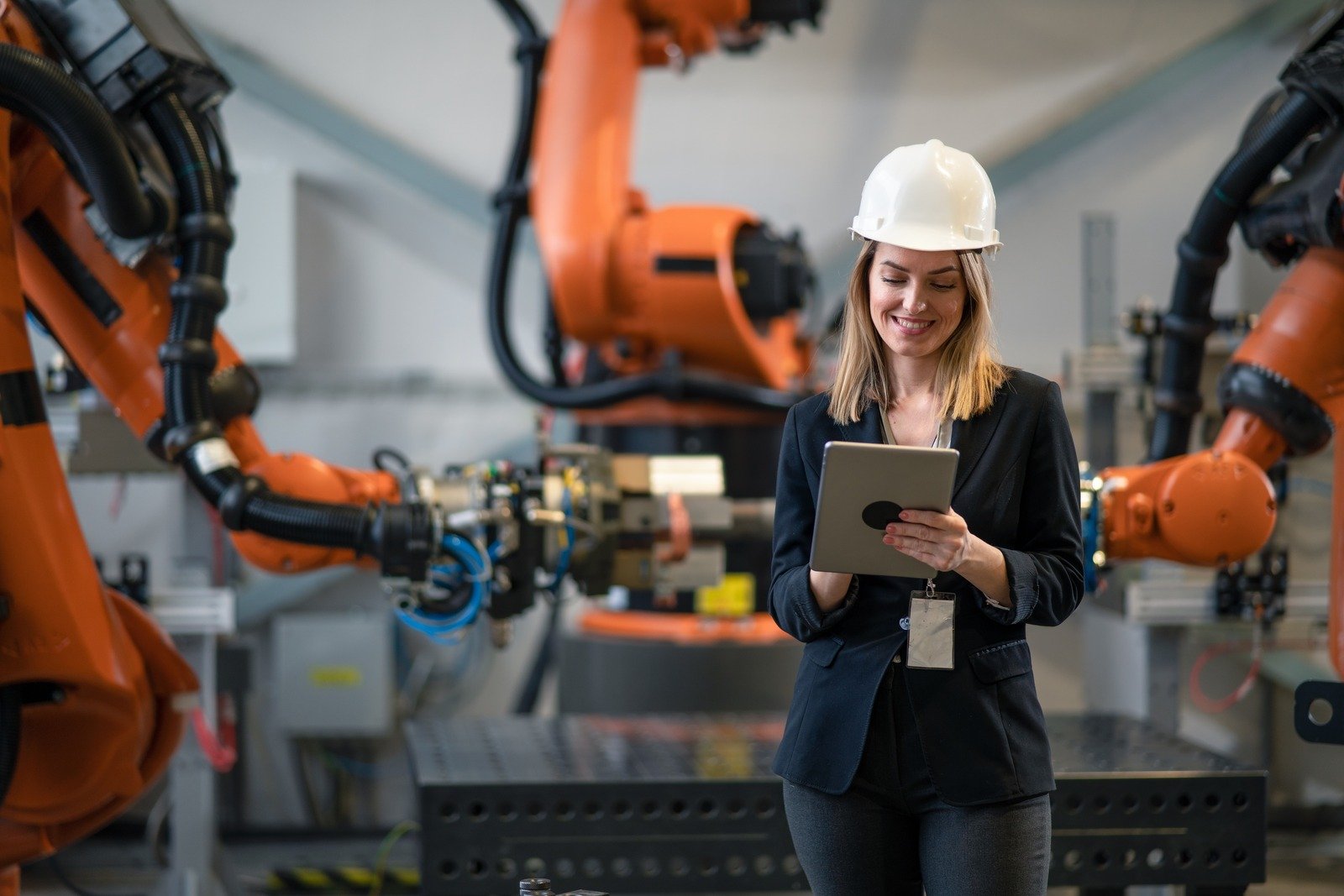
What Is a Smart Factory?
Smart factories are becoming a critical component of modern manufacturing operations as businesses seek to stay competitive in an increasingly automated landscape. According to a 2023 report, 97% of manufacturers have already adopted or plan to adopt smart factory technology.1
The urgency to adopt smart manufacturing practices is fueled by the need to address challenges facing the industry, including rising customer demands, staffing challenges, and supply chain vulnerabilities. Over 82% of manufacturers believe smart factory technology is key to their organization’s future success2 – so if your business hasn't embraced smart manufacturing yet, it's time you do so.
In this blog, we'll break down what smart factories are, the technologies that power them, and the steps you can take to modernize your manufacturing operations today.
What Is a Smart Factory?
A smart factory is a highly digitized and connected manufacturing facility that collects and shares data through integrated systems, machinery, and intelligent devices. This data is then analyzed to inform decisions, improve processes, and proactively address potential issues. The goal of a smart factory is to create a fully integrated, collaborative, and self-optimizing manufacturing environment that can easily adapt to changing demands and market conditions.

What Are Industry 4.0 Smart Factory Technologies?
Smart factories rely on a range of Industry 4.0 technologies, including:
Industrial Internet of Things (IIoT)
The Industrial Internet of Things (IIoT) enables seamless communication and data exchange between the devices, machines, and processes within a smart factory. IIoT systems are equipped with sensors that continuously collect data points from various stages of the manufacturing process, providing real-time visibility into operations for data-driven decision-making.
These sensors allow manufacturers to track and optimize every aspect of their operations by monitoring key parameters, such as temperature, pressure, vibration, and equipment performance. With IIoT technology, manufacturers can identify bottlenecks, detect potential issues before they occur, and make decisions based on accurate, up-to-date data.
Big Data Analytics
Smart factories generate massive amounts of data from connected devices, sensors, and systems across the entire production process. This data, often called "big data," can be overwhelming to manage and analyze using traditional methods. Advanced algorithms and high-performance computing power big data analytics technologies, eliminating manual analysis and potential human errors.
By uncovering valuable insights, identifying patterns, and correlating disparate data sources, big data analytics empowers manufacturers to make informed decisions and drive continuous improvement. For example, it can analyze historical data and identify patterns that indicate potential equipment failure, allowing workers to schedule maintenance before breakdowns occur for reduced downtime and increased operational efficiency.
Cloud Computing
Cloud computing provides manufacturers the flexibility and scalability needed to store, process, and share data across a smart factory. Connected devices and machines can quickly upload data to the cloud, enabling real-time analysis and decision-making across the entire manufacturing process.
By leveraging cloud computing, manufacturers can access powerful computing resources on-demand without needing expensive on-premises infrastructure. This ensures manufacturers can access the latest technologies and scale their operations as needed, enabling agility and responsiveness to changing market conditions.
Artificial Intelligence and Machine Learning
Over 50% more manufacturers used artificial intelligence and machine learning tools in 2023 compared to 2022.1 AI and ML technologies allow automated decision-making, process optimization, and self-correction. These technologies can analyze massive amounts of data to identify inefficiencies and recommend or implement intelligent workflows and automated processes, leading to continuous improvement and optimization.
Machine learning algorithms enable smart production systems to optimize processes in real-time by learning from historical data and adapting to changing conditions. AI tools can also analyze production data, identify patterns, and adjust parameters such as temperature, pressure, or feed rates to improve product quality and reduce waste.

Virtual and Augmented Reality
Virtual reality (VR) and augmented reality (AR) are changing how operators interact with smart factories. Manufacturers can use VR solutions for training and simulation, allowing workers to practice complex tasks in a safe and controlled virtual environment to reduce the risk of accidents and improve skill development.
AR overlays digital information to provide workers with contextual data and instructions for maintenance, assembly, and quality control tasks. It can project step-by-step instructions, diagrams, and real-time data directly into the worker's field of view to improve efficiency, accuracy, and safety during complex operations.
Digital Twins
Digital twins are virtual replicas of physical processes, assets, or production lines in a smart factory. These digital representations are continuously updated with real-time data from sensors and other sources, creating a comprehensive digital model that mirrors the behavior and performance of the physical counterpart.
Digital twins let manufacturers simulate and test scenarios without disrupting actual production processes. This allows for safe experimentation, optimization, and what-if analyses, ultimately leading to improved efficiency, reduced downtime, and better decision-making. Additionally, digital twins can be used for predictive maintenance by monitoring the virtual model for signs of potential failures or degradation, preventing costly breakdowns.
What Are the Benefits of a Smart Factory?
Implementing smart factory technologies offers several advantages for manufacturing businesses, including:
Increased Efficiency
One of the most prominent benefits of a smart factory is increased efficiency. By continuously monitoring and optimizing processes, smart manufacturing businesses can reduce downtime, minimize waste, and maximize resource utilization.
Predictive maintenance, enabled by advanced analytics and machine learning, allows manufacturers to anticipate equipment failures and schedule maintenance before breakdowns occur, minimizing unplanned downtime and reducing maintenance costs. Automated workflows and intelligent process optimization can streamline operations, eliminating bottlenecks and improving throughput.
Improved Quality Control
83% of manufacturers believe smart factory technologies will transform how products are made within the next five years.3 Advanced analytics and real-time data monitoring enable smart factories to run predictive quality assurance, reducing defects and ensuring consistent product quality. By analyzing data from process parameters, material characteristics, and environmental conditions, smart factories can identify deviations from optimal conditions and take corrective actions before defects occur.

Cost Savings and Resource Optimization
Smart factories help manufacturers lower operational costs and maximize the utilization of resources by optimizing processes, reducing waste, and enabling predictive maintenance. Predictive maintenance can extend the lifespan of equipment, while process optimization can minimize material waste and energy consumption. Additionally, automated workflows and intelligent resource allocation can optimize labor utilization, reducing overhead costs and improving overall productivity.
Increased Worker Safety
Automated processes and real-time monitoring capabilities in smart factories can help manufacturers identify and mitigate safety hazards to reduce the risk of staff accidents and injuries. By removing workers from hazardous environments and automating dangerous tasks, smart factories can significantly improve workplace safety.
AR solutions can provide workers with real-time safety instructions and alerts to make them aware of potential hazards and take appropriate precautions. Combining automation, real-time monitoring, and advanced safety technologies in smart factories can create a safer and more secure working environment.
Enhanced Flexibility
Smart factories are flexible and agile, enabling manufacturers to easily adapt to changing market demands, customer preferences, and production requirements. They can leverage data analytics and intelligent automation to reconfigure production lines, adjust process parameters, and optimize workflows, allowing manufacturers to respond quickly to evolving trends and capture new market opportunities.
Supply Chain Visibility
76% of manufacturing organizations aim to gain more visibility into their supply chain by adopting digital tools.3 Smart factories improve visibility into the entire supply chain by connecting data from suppliers, logistics providers, and manufacturing operations. This end-to-end transparency enables manufacturers to track the movement of raw materials, components, and finished goods in real-time, identifying potential bottlenecks or disruptions before they occur.

What Are the Four Levels of a Smart Factory?
The journey towards becoming a fully-fledged smart factory is a gradual process that involves implementing smart manufacturing technologies and integrating them into existing operations. These four levels of data structure can help you evaluate your manufacturing organization's progress and identify the steps needed to move to the next level.
Level 1: Data Availability
On the first level, data is collected throughout the facility, but it isn't easily accessible or organized for analysis. Data processing and analysis often require manual effort, which can hinder a manufacturer's ability to gain valuable insights and make informed decisions.
Level 2: Data Accessibility
In the second level, data is structured and organized, making it more accessible for proactive analysis. Visualization tools and dashboards are available to clearly represent the data. However, human input is still required for data interpretation and decision-making, as the production process systems lack advanced analytics capabilities.
Level 3: Active Data Analysis
At the third level, machine learning and artificial intelligence are employed to generate insights and identify issues or anomalies with minimal human supervision. The system can process and analyze large volumes of data, detect patterns, and predict potential failures or bottlenecks. Relevant personnel are alerted to these insights so that proactive measures can be taken.
Level 4: Action-Oriented Data
The fourth and most advanced level of a smart factory involves fully automated data collection, analysis, and corrective actions. Machine learning and AI algorithms can not only identify issues but also generate and implement solutions with little to no human intervention. Data collection, analysis, and optimization are seamlessly integrated into the manufacturing processes, enabling real-time adjustments and continuous improvement.
What Is the Role of OT in a Smart Factory?
Operational technology (OT) – the hardware and software systems that control physical devices, processes, and events in the manufacturing sector – plays a big role in Industry 4.0. OT serves as the bridge between traditional manufacturing processes and digital technologies, enabling smart factories via:
IT Integration
Smart factories integrate OT systems with IT systems, facilitating real-time data exchange and analytics. This IT/OT convergence enhances operational efficiency by automating data collection and analysis. It also provides greater flexibility to adapt to changing demands and allows for more responsive operations by providing real-time visibility into production.
Automation and Robotics
OT provides monitoring capabilities to track and control the automated equipment, robotic arms, autonomous guided vehicles, and other automated systems on the smart factory floor.
Cyber-Physical Systems
OT is crucial in the development and management of cyber-physical systems (CPS), which use smart sensors and actuators to collect data from and control physical industrial processes. The OT systems provide the hardware interface and data collection capabilities that make these cyber-physical systems possible in a smart factory.
Interoperability and Standards
With connected OT systems playing such a central role, interoperability and adherence to standards are essential for a smart factory. Open standards allow the many different makes and models of OT systems, machines, and devices to integrate and share data seamlessly.
Partner With Andromeda for Your Smart Factory Transformation
Smart factory technologies are revolutionizing the manufacturing industry. By leveraging the power of Industry 4.0 technologies, such as the Industrial Internet of Things, big data analytics, artificial intelligence, and cloud computing, smart factories enable manufacturers to achieve unprecedented levels of efficiency, quality, and agility.
Partnering with an experienced managed IT provider like Andromeda is key for manufacturing companies looking to optimize their smart factory technologies. As the only technology provider in the Midwest specializing in serving manufacturing companies, Andromeda has helped keep manufacturers safe, secure, and running smoothly with proactive IT services and hands-on support.
Ready to transform your manufacturing process? The Andromeda team is here to help. Book a meeting today to learn more about how we can help you unlock new levels of productivity.
Sources:
- https://www.rockwellautomation.com/content/dam/rockwell-automation/documents/pdf/campaigns/state-of-smart-2023/State-of-Smart-Manufacturing_RockwellAutomation_INFO-BR027B-EN-P.pdf
- https://www.plex.com/sites/default/files/2022-05/10289_7_SOSM_Report.pdf
- https://www2.deloitte.com/us/en/insights/industry/manufacturing/manufacturing-industry-outlook.html
Keep Your Business Safe, Secure, and Running
We’ll take a proactive approach to your manufacturing IT – and help your business blast off.





